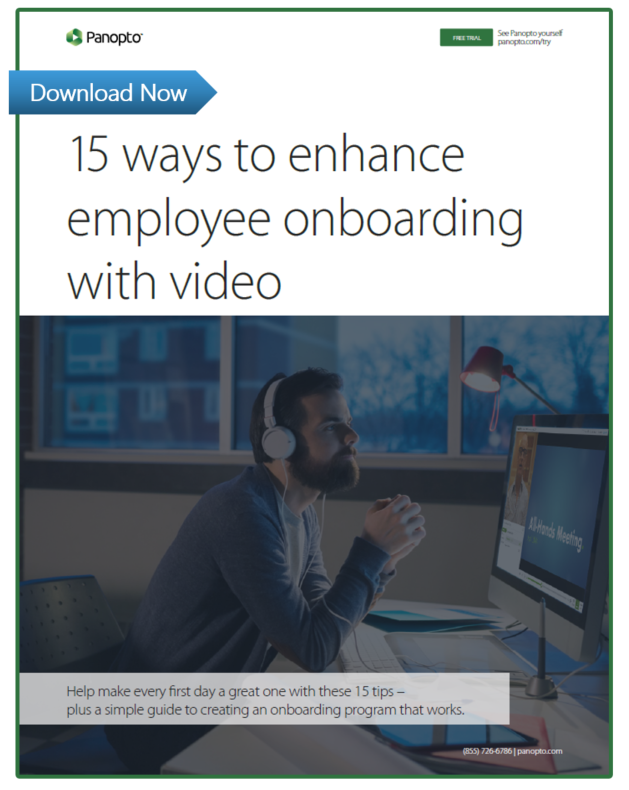- Communications
3 Avoidable Employee Onboarding Mistakes
Many of the biggest onboarding challenges your new hires face relate to absorbing important information. According to a recent survey, the most frequently cited challenges from recently hired employees and managers included:
- Learning new processes
- Learning new technologies
- Understanding corporate culture
Organizations are increasingly putting structured employee onboarding programs in place to ensure that all new hires get this information in their first couple of days. But even well-planned onboarding processes have limitations in delivering this information in a way that new recruits can easily digest and then retain over time.
Although the details covered in new employee orientation will differ from company to company, “information overload” can lead to three common onboarding mistakes. Here’s how you can avoid each.
1. Information overload during face-to-face orientation
Large companies often have half-day or day-long orientation events, in which new hires are bombarded with information in the form of 30-60 minute back-to-back presentations.
The parade of executives and subject matter experts cover everything from company mission and strategy to organizational structure, values, performance management, benefits, legal, safety and security, network access, health plans, and internal tools and resources. Although these sessions can often be invigorating, the amount of information conveyed is typically overwhelming.
Instead of trying to pack 40 hours worth of information into an 8-hour orientation, prioritize what’s most important to cover with all new hires and take additional time in the face-to-face orientation to cover that in depth – then provide video training for the rest.
Video platforms make it easy to record high-quality online presentations for your new recruits using nothing more than a webcam and PowerPoint or Keynote. These videos can be stored centrally in your company’s video training library, where new hires can watch them during their first few weeks on the job, and refer back to them anytime in the future.
Watch an example onboarding video about employee benefits:
2. Neglecting cultural adaptation
In the bestselling book, The First 90 Days, Michael Watkins cites cultural adaptation as one of the four critical pieces of the onboarding puzzle. Watkins’ research shows that this is important for all new employees, and particularly vital for new managers, with lack of cultural adaptation being the most common reason newly-hired managers fail.
Video provides a perfect medium for communicating company culture. Through the use of a centralized video platform, new employees can learn about company values from executives and co-workers. Video helps ensure consistency in communication, and it makes this information available to watch or re-watch anytime.
Here are four examples of company culture videos you can create:
-
From the CEO – Company culture starts at the top. There’s no better way for a CEO to impart company values and culture in a scalable way than through video. As CEO of NYSE Technologies, Stanley Young took this a step further, recording short, weekly videos that could be seen by his employees around the world.
-
Human resources – The HR team is one of your best resources for understanding company-wide and team-specific culture. Videos can help new hires learn about a team’s communication style, typical and expected behaviors, leadership styles, and more.
-
Employees – Identify “culture carriers” within your organization and have them discuss cultural norms and best practices in their own words. Culture carriers typically aren’t members of the senior leadership team. Instead, they’re often well-connected managers, charismatic individual contributors, or administrative assistants.
-
Record an actual meeting – There’s no better way to prepare a new recruit for what they’ll face culturally in their first meeting than by recording one. Recording a meeting shows new employees what to expect with the in-meeting communication protocol and how decisions are made.
3. Deprioritizing onboarding for senior-level employees
According to 2005 research from Right Management Consultants, 35% of new managers and executives fail within 18 months of taking a new position. And improving leadership development ranks in the top 5 human capital priorities for CEOs according to The Conference Board’s CEO Challenge 2014 report. But management and leadership skills can often be overlooked as part of a new senior employee’s onboarding process.
Video can help here as well. Here are a few ideas for creating onboarding videos geared specifically toward new managers and leaders within your organization:
-
The hiring process – These videos describe your organization’s selection criteria, recruiting procedures, interview expectations, and decision process.
-
Performance management – In these videos, you describe the employee objective setting process, what’s expected from managers for performance coaching, the appraisal process, and how your company manages under-performers.
-
Leadership competencies – Different organizations place different priority on various leadership qualities. Some place a higher value on managing cross-org communication and coordination, while others may place a higher value on taking risks and innovating. Knowing your company’s leadership competencies from the outset can help set your managers and leaders up for success.
-
Navigating organizational structure – These videos provide managers and executives with cross-training on the various teams and other executives they’ll be expected to interact with.
-
Best practice sharing – Other successful executives within a company can be a new leader’s best resource for understanding what works and what doesn’t. But executive time constraints often mean that face-to-face meetings to discuss best practices aren’t possible. Record them instead. A series of short videos by well-regarded executives can provide new leaders with valuable information that can help them adapt to the company culture.

Get The Guide To Using Video For Onboarding
These are just a few of the ways that video can benefit your employee onboarding program. Interested in finding out more? We wrote the book on supporting your employee onboarding initiatives with video – download your free copy today.



